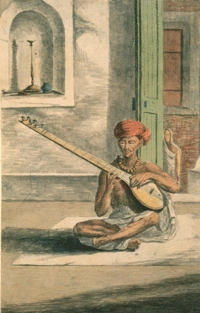 Premla Shahane playing a sitar, 1927
Premla Shahane playing a sitar, 1927The sitar is a Hindustani classical instrument. Acoustic sitars typically have a gourd acting as the resonating chamber. A distinctive feature are the curved frets, which are movable (allowing fine variation in tuning) and raised (so that resonant, or sympathetic, strings can run underneath the frets, giving a very lush sound). A typical sitar has 18, 19 or 20 strings (depending on the style) there are 6 (in the Vilayat Khan style) or 7 (in the Ravi Shankar style) playable strings on top and 11, 12 or 13 sympathetic strings or tarbs under the frets. It is rather difficult to tune the instrument. The strings can be tuned using both the pegs on the sides or the 'beads' at the bottom, which are mainly for fine tuning.
Contents |
Etymology and History
The origin of the name, sitar is from Persian, like some other words used in Indian musical terminology. The corresponding Persian name is sehtar, (seh means three and tar means string) meaning three strings. In Afghanistan, the sitar is also used and is pronounced "sehtar." However, there are significant differences between the sehtar and sitar, suggesting that the sitar developed later and is possibly a direct descendant of the sehtar, which is in turn derived from the Kurdish tembūr Both the tembūr and sehtar were used in pre-Islamic Persia and are used in Iran today. It is also quite likely that the sitar is an adaption of the much older Indian instrument the rudra veena.
Playing the Sitar
 An etching of an Indian man playing a sitar,
18th century
An etching of an Indian man playing a sitar,
18th century
The dominant hand is used to pluck the string using a metallic plectrum called the mezrab. Traditional approaches to learning the sitar involve a long period of apprenticeship under the tutelage of a master during which the apprentice would accompany the master with a tambura, providing a droning chord harmony for the sitar's melody. Nowadays it is possible to purchase books and videos to assist home learning. The sitar became popular in the West when The Beatles used it in "Norwegian Wood (This Bird Has Flown)", "Love You To", "The Inner Light", "Tomorrow Never Knows", and "Within You Without You". Beatles guitarist, George Harrison, was inspired by and later taught by Ravi Shankar.
Learning to play the sitar is a difficult process. The entire 3 octave range of the instrument is achieved by sliding the index finger of the left hand up and down the neck of the sitar over a single melody string, while the mezrab on the index finger of the right hand strikes the string. Thus it demands a very high degree of technical mastery to play even simple melodies with clarity and accuracy. It is also a rather painful process for the beginner until the hard calluses and black grooves on the tips of the index and middle finger, which typify the sitar player, begin to develop. A specialised technique called "Meend" involves pulling the main melody string down over the bottom portion of the sitar's curved frets, with which the sitarist can achieve a 7 semitone range of microtonal notes. Meend gives the sitar its characteristic fluid sound, but typically takes the sitarist a decade or more of hard practice to achieve with fluency and precision.
In one of the more common tunings (used by Ravi Shankar among others) the strings are tuned C C G C G C F. The sympathetic strings are tuned depending on the raga, although for beginners it is acceptable to tune them according to a C major scale: C, D, E, F, G, A, B, C, D, E. This corresponds with the Indian scale Sa Re Ga Ma Pa Dha Ni Sa Re Ga.
When playing sitar, the thumb of the plucking hand should stay on the side of the fretboard just above the main bowl, the plucking arm should carry all of the weight of the sitar by applying pressure to the main bowl with the elbow and other arm muscles, the fingering hand should move freely without having to carry any of the weight. Generally only the index and middle fingers are used for fingering.
Notable sitar players
Imdad Khan
Enayat Khan
Ravi Shankar
Vilayat Khan
Mustaq Ali Khan
Nikhil Banerjee
Imrat Khan
Abdul Halim Zaffar Khan
Rais Khan
Sanjoy Bandopadhyay
Anjan Chattopadhyay
Purbayan Chatterjee
Debu Chowdhuri
George Harrison
Budhaditya Mukherjee
Manilal Nag
Shahid Parvez
Anoushka Shankar
Peter van Gelder
Kushal Kumar Das
Rabindra Narayan Goswami
Brian Jones
Anton Newcombe
External links
- Nay-Nava the encyclopedia of Persian music instruments
- Hindustani Music Resources
- Information on the Sitar
- An on-line tutorial on Sitar for beginners
- Maintaining and repairing a sitar
- History and Origins of the Sitar
- Pictures and films of an electric sitar
- Online sitar lessons for students of any level
- Online and off-line sitar lessons for students of any level
- All levels of Sitar, sales and repairs.
- Ramu & Goswami Web site for Rabindra Narayan Goswami (sitar) and A. Ramchandra Pandit (tabla).
Categories: String instruments




 216.73.216.190
216.73.216.190 User Stats:
User Stats:
 Today: 0
Today: 0 Yesterday: 0
Yesterday: 0 This Month: 0
This Month: 0 This Year: 0
This Year: 0 Total Users: 117
Total Users: 117 New Members:
New Members:
 216.73.xxx.xxx
216.73.xxx.xxx
 Server Time:
Server Time: